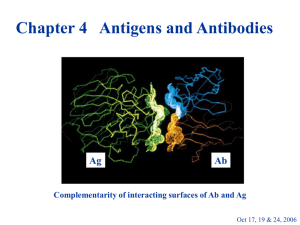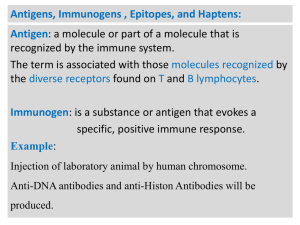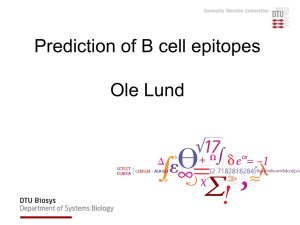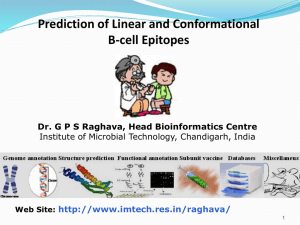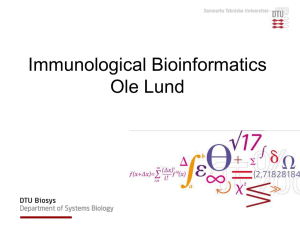BIOT 307 Kuby, Ch. 3, Antigens
advertisement
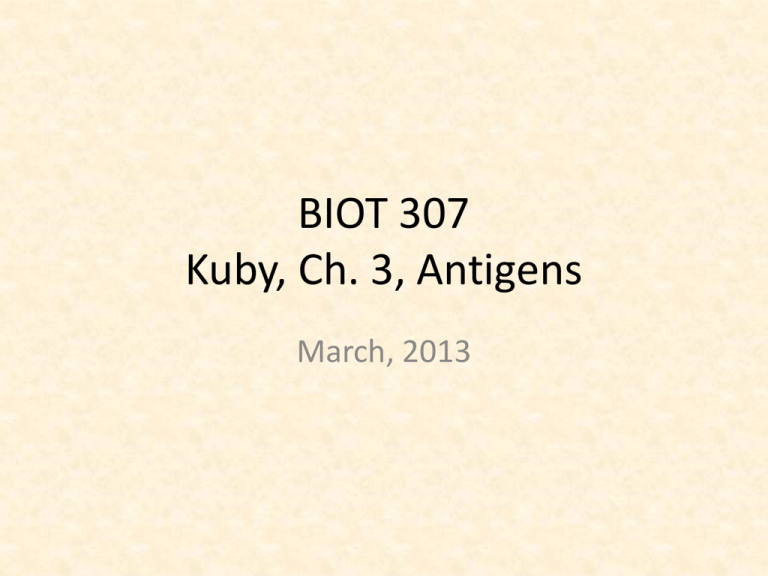
BIOT 307 Kuby, Ch. 3, Antigens March, 2013 General Introduction • Specificity due to recognition of antigenic determinants or epitopes • Epitopes = immunologically active regions that bind to: – Ag-specific membrane receptors on lymphocytes – Secreted antibodies • Multiple epitopes can be found on single macromolecule ANTIGENS = SUBSTANCES RECOGNIZED BY • immunoglobulin receptor of B cells • T- cell receptor when complexed with MHC • Host determines whether B or T cell’s antigenbinding receptor actually induces immune response • B and T cell recognition are different Immunogenicity and Antigenicity • Immunogenicity = ability to induce humoral and/or cell- mediated immune response • Antigenicity = ability to combine specifically with the final products of the above responses (i.e., antibodies and/or cell-surface receptors). • Haptens, small molecules, are antigenic but incapable of inducing specific immune response FACTORS INFLUENCING IMMUNOGENICITY • Type of molecule: – Protein and polysaccharides immunogenic – Lipids and nucleic acids must be conjugated with another molecule, i.e., like above PROPERTIES DETERMINING IMMUNOGENICITY Foreignness or non-self • Non-self antigens are eliminated by recognition and response • lymphocytes that recognize self antigens are eliminated by inactivation • Antigens that are more foreign are more immunogenic – Exceptions: • Collagen and cytochrome c – similar in all species • Corneal tissue and sperm - kept apart from immune system Molecular Size • > 100,000 Da: excellent • < 5,000-10,000: poor Chemical Composition and Heterogeneity • Homopolymers: poor • Protein structure: 1’, 2’, 3’, 4’ all contribute • Lipids serve as haptens Ab against lipids useful – leukotrienes, steroids, vitamins Susceptibility to Ag processing and presentation • Interaction of T-cells with processed Ag • Processing by: MΦs, neutrophils • Presentation via APCs (MΦs, DCs, B cells, mast cells) • Larger molecules more easily phagocytosed HOST CONTRIBUTES TO IMMUNOGENICITY • Genes in MHC • Genes that encode B and T-cell receptors • Genes involved in immunoregulation EVIDENCE - Mice • Inbred strains of mice respond differently to Ag • F1 generation – intermediate • Backcross analysis mapped differences to MHC subregion HOST CONTRIBUTES TO IMMUNOGENICITY EVIDENCE – Humans • HLA determines immune response to some pathogens • African-Americans respond poorly to interferon-α • HLA-DR4 associated with high responsiveness to antigens specific to M tuberculosis but not to antigens shared with other mycobacteria (p = 0.0005) HOST CONTRIBUTES TO IMMUNOGENICITY Immunogen dosage • Dose response – Not enough to activate lymphocytes or tolerance – Too much tolerance Example: capsular polysaccharide – O.5 mg: no IR – 0.0005 mg: Ab response IMPORTANCE OF BOOSTERS: clonal proliferation HOST CONTRIBUTES TO IMMUNOGENICITY Immunogen route of administration • Routes: experimental Ag via intravenous (IV), intradermal (ID), subcutaneous (SC), intramuscular (IM), intraperitoneal (IP) • Influences which immune organs, tissues and cells – IV spleen – Subcutaneously local lymph nodes HOST CONTRIBUTES TO IMMUNOGENICITY Immunogen route of administration • Routes: vaccine Ag via intramuscular (IM), oral, subcutaneous (SC), • Influences which immune organs, tissues and cells – SC and IM local lymph nodes – Oral MALT ROLE OF ADJUVANTS ADJUVANTS = substances administered with Ag enhance immunogenicity Uses: low immunogenicity OR only small amounts of Ag available Mechanism of action: 1. Ligands for TLR on DCs and MΦ 2. Prolong Ag persistence “depot effect” 3. Enhance costimulatory molecules 4. Increase local inflammation 5. Stimulate nonspecific lymphocyte stimulation ADJUVANT TYPES HUMAN USE • Alum – aluminum potassium sulfate – APPROVED • MF59® – water in oil emulsion, Th1 and Th2 – APPROVED in EU • AS04 IN DEVELOPMENT: molecular mechanism based adjuvants ANIMAL USE ONLY • Freund’s incomplete adjuvant NOT USED EVEN IN ANIMALS • Freund’s complete adjuvant EPITOPES • immune cells do not interact with, or recognize, entire immunogen molecule • Lymphocytes recognize discrete sites on immunogen molecule called epitopes, or antigenic determinants. • Epitopes are the immunologically active regions of an immunogen that bind to antigen-specific membrane receptors on lymphocytes or to secreted antibodies • Studies with small antigens reveal that B and T cells recognize different epitopes on same antigenic molecule B-CELL EPITOPES • Hydrophilic amino acids on protein surface – Protruding regions – Interior is hydrophobic; must be denatured to be open to Ab • These recognize membrane bound or free Ab B-CELL EPITOPES B-CELL EPITOPES • 15 - 22 amino acids on Ag contact Ab • 75–120 hydrogen bonds as well as by ionic and hydrophobic interactions. Conformational Epitope • Ag-Ab binding due to weak non-covalent interactions operating over short distances • Precise complementary shapes increase noncovalent bonding • Smaller ligands such as carbohydrates, small oligonucleotides, peptides, and haptens often bind within deep pocket of Ab • B-cell epitopes tend to be located in flexible regions of an immunogen and display site mobility • Complex proteins contain multiple overlapping B-cell epitopes • Only some are immunodominant • Determined with monoclonal antibodies (MAbs) • More potential antigenic sites than number recognized by immune system – Varies from species to species – Within species, individuals can • recognize different epitopes as immunogenic and • mount immune responses that are stronger (immunodominant) against different epitopes T CELL EPITOPES • Antigen processing is required to generate peptides that interact specifically with MHC molecules • Epitope is not conformational rather linear • Epitopes recognized by T cells are often internal • given MHC molecule can selectively bind variety of different peptides • Antigen processed into antigenic peptides are presented in combination with MHC molecules • Antigenic peptides recognized by T cells form trimolecular complexes with T-cell receptor and MHC molecule HAPTENS haptens, small organic molecules that are antigenic but not immunogenic Become immunogenic when linked to carrier molecule, e.g., large protein drugs, peptide hormones, and steroid hormones USE OF HAPTENS • Configuration plays major role in determining whether it can react with a given antibody • drugs, peptide hormones, and steroid hormones

